| Apr 04, 2006 |
Ultra-sensitive detection of trace amounts of proteins using fluorescent nanoparticles
|
|
(Nanowerk News) The >National Institute of Advanced Industrial Science and Technology (AIST) in Japan has succeeded in the synthesis of unique high quality fluorescent quantum dots, and the development of nano-biohybrid materials for protein and DNA/RNA measurements using quantum dots. Furthermore, AIST has made the first confirmation that the materials can be applied for detection of trace amounts of proteins in cell lysates using antibodies (immunoblotting).
|
|
The quantum dots are particles of several nanometers in diameter, which are formed by inorganic semiconductor substances. Because the quantum dots can emit strong fluorescence by ultraviolet irradiation, they have attracted attention for use as optical materials for bioimaging, biosensing, photosensitizing, etc., thus resulting in intense world-wide competition in their research and development.
|
|
The AIST has succeeded in the preparation of high quality quantum dots which have the following characteristics: 1) high-luminescence performance, 2) effective size-distribution, 3) high photochemical stability, 4) non-aggregation, and 5) non-blinking. Furthermore, the AIST has successfully synthesized avidin- or biotin-conjugated quantum dots, and by the combination of both quantum dot hybrid materials, dramatically enhanced the sensitivity of antibody-based detection of proteins.
|
 |
Fluorescence emitted from quantum dots.
Blue fluorescence can be emitted from small particles of approximately 2 nm in diameter, green from ∼3 nm particles, yellow from ∼4 nm particles, and red from large particles of ∼5 nm. The wavelength of the excitation light is 365 nm. (Source: AIST)
|
|
Hereafter, AIST will utilize this technique for the development of electrophoresis tips to detect and identify native proteins. Furthermore, they plan to develop surface treatment techniques for quantum dots to specifically label objectionable fungi and foreign substances invading various food production processes including the production of fermented food, and apply the techniques developed to evaluation of the optimal process management.
|
|
The results in this work have been published in Journal of American Chemical Society, 2005, 127(26), 9328, and Analytical Chemistry, 2006, 87(1), 321, which are both journals of the American Chemical Society. The results were also presented at "NanoTech 2006 International Nanotechnology Exhibition & Conference" held at Tokyo Big Sight on February 21-23.
|

